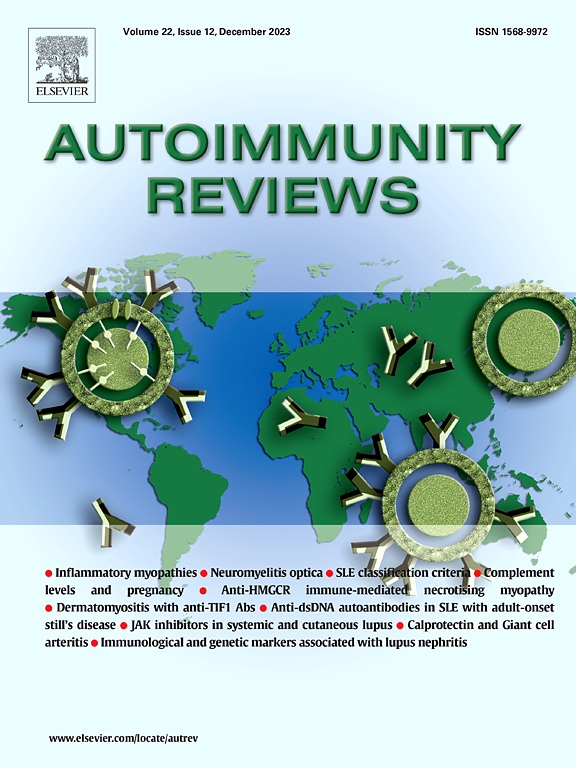Emerging roles of mechanically activated ion channels in autoimmune disease
IF 8.3
1区 医学
Q1 IMMUNOLOGY
引用次数: 0
Abstract
Mechanically activated (MA) ion channels have rapidly gained prominence as vital conduits bridging aberrant mechanical cues in tissues with the dysregulated immune responses at the core of autoimmune diseases. Once regarded as peripheral players in inflammation, these channels, exemplified by PIEZO1, TRPV4, and specific K2P family members, now play a central role in modulating T-cell effector functions, B- cell activation and the activity of macrophages and dendritic cells. Their gating is intimately tied to physical distortions such as increased tissue stiffness, osmotic imbalances, or fluid shear, triggering a cascade of ionic fluxes that elevate proinflammatory signaling and drive tissue-destructive loops. Recognition of these channels as central mediators of mechanical stress-induced inflammation responses in autoimmune pathogenesis is rapidly expanding. In parallel, the emerging therapeutic strategies aim to restrain overactive mechanosensors or selectively harness them in affected tissues. Small molecules, peptide blockers, and gene-targeting approaches show preclinical promise, although off-target effects and the broader homeostatic roles of these channels warrant caution. This review explores how integrating mechanobiological concepts with established immunological paradigms enables a more detailed understanding of autoimmune pathogenesis. By elucidating how mechanical forces potentiate or dampen pathological immunity, we propose innovative strategies that exploit mechanosensitivity to recalibrate immune responses across a spectrum of autoimmune conditions.

机械激活离子通道在自身免疫性疾病中的新作用
机械激活(MA)离子通道作为连接自身免疫性疾病核心免疫反应失调组织中异常机械信号的重要通道,已迅速得到重视。这些通道,如PIEZO1、TRPV4和特定的K2P家族成员,曾经被认为是炎症的外围参与者,现在在调节t细胞效应功能、B细胞激活以及巨噬细胞和树突状细胞的活性方面发挥核心作用。它们的门控与物理扭曲密切相关,如组织刚度增加、渗透失衡或流体剪切,触发离子通量级联,提高促炎信号并驱动组织破坏回路。对这些通道作为自身免疫发病机制中机械应力诱导炎症反应的中心介质的认识正在迅速扩大。与此同时,新兴的治疗策略旨在抑制过度活跃的机械传感器或选择性地在受影响的组织中利用它们。小分子、肽阻滞剂和基因靶向方法显示出临床前的前景,尽管这些通道的脱靶效应和更广泛的稳态作用需要谨慎。这篇综述探讨了如何将机械生物学概念与已建立的免疫学范式相结合,从而更详细地了解自身免疫发病机制。通过阐明机械力如何增强或抑制病理性免疫,我们提出了利用机械敏感性来重新校准免疫反应的创新策略。
本文章由计算机程序翻译,如有差异,请以英文原文为准。
求助全文
约1分钟内获得全文
求助全文
来源期刊

Autoimmunity reviews
医学-免疫学
CiteScore
24.70
自引率
4.40%
发文量
164
审稿时长
21 days
期刊介绍:
Autoimmunity Reviews is a publication that features up-to-date, structured reviews on various topics in the field of autoimmunity. These reviews are written by renowned experts and include demonstrative illustrations and tables. Each article will have a clear "take-home" message for readers.
The selection of articles is primarily done by the Editors-in-Chief, based on recommendations from the international Editorial Board. The topics covered in the articles span all areas of autoimmunology, aiming to bridge the gap between basic and clinical sciences.
In terms of content, the contributions in basic sciences delve into the pathophysiology and mechanisms of autoimmune disorders, as well as genomics and proteomics. On the other hand, clinical contributions focus on diseases related to autoimmunity, novel therapies, and clinical associations.
Autoimmunity Reviews is internationally recognized, and its articles are indexed and abstracted in prestigious databases such as PubMed/Medline, Science Citation Index Expanded, Biosciences Information Services, and Chemical Abstracts.
 求助内容:
求助内容: 应助结果提醒方式:
应助结果提醒方式:


